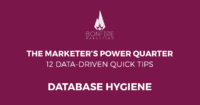Are you concerned your audience isn’t properly engaging with your content, or maybe that they aren’t finding your conversion pages the way you’d like them to? Are certain traffic channels underperforming and you don’t know why? What about the layout of the site? Is the user experience not as strong as it could be?
These are all pressing questions with difficult answers, but Google Analytics’ Behavior Flow Report and In-Page Analytics visualizations are here to help.
The Behavior Flow Report visualizes your traffic to help you understand exactly how users traverse your site, which pages they visit the most, and why and when they leave. The flow report can isolate different traffic sources, as well as paid and organic keywords to analyze how those different visitors behave. It can help you determine the paths users took to create a successful visit (i.e., a conversion), as well as any potential roadblocks that may cause your users to leave.

Are you unclear how your site’s layout influences user navigation? The In-Page Analytics Report shows you which links get the most clicks on any given page, providing insight into how to optimize your site’s design and arrange links and layouts to get users to the most valuable pages on your site.
Together, the Behavior Flow and In-Page Analytics reports can help you maximize your site’s usefulness and get more visitors further down your conversion funnel.
Analyze user engagement with the Behavior Flow report
The Behavior Flow report visualizes the paths users take from one page – or events, if you are tracking them – to the next. This report can help you understand which content is keeping users engaged and what’s causing people to leave the site. It may also identify potential content and design issues. For example, if a certain blog post is getting a lot of views and engagement but then causes a majority of the visitors to promptly leave, are you certain you have the right calls to action, conversion pitches, or navigation? This report can help.
Google cites several interesting examples of the types of questions the Behavior Flow Report can answer:
- Did the user go straight from a product page to a checkout page and convert? Did they view any additional products along the way?
- Is one event regularly triggered, leading to more events or pageviews? Are there events that don’t lead to any additional engagement?
- Are certain paths through your website more popular than others? Is this the path you want your users to follow or does it fall outside your conversion funnel?
The Behavior Flow report can also help inform your sales conversion funnel. If you’re seeing a traffic flow pattern that regularly converts, consider setting up a conversion funnel and further optimizing those pages.
Anatomy of the Behavior Flow report: connections, drop-offs, and loopbacks
At first, the Behavior Flow Report may appear confusing and overly busy, but it’s actually quite simple. Let’s break it down:
- Connections: Gray bands flowing between the different levels of interaction, which are called “nodes.” They represent the path your traffic takes from one node to the next. Thicker bands mean more traffic flowed through those connections.
- Drop-offs: Also called exits, these are red bands indicating where the user left the site. Again, the thicker the band, the more users exited at that interaction.
- Loopbacks: If you see a connection returning to the previous node, the user is looping back. While it’s great your users aren’t dropping off, a loopback might indicate they didn’t find what they need, and aren’t continuing down your funnel.

How to use In-Page Analytics
In-Page Analytics is a valuable tool that helps you visually assess how your visitors engage with your site’s pages. As Google mentions, it can effectively answer engagement and user experience questions like:
- Which links do visitors click on the most? Is it because of placement?
- Does my design and layout successfully get visitors to accomplish my site’s goals or move further down the conversion funnel?
- Do the visitors see the content I want them to see, or is something buried too below the fold to be easily found?
- Are calls to action visible and compelling enough for visitors to follow?
You can either access the In-Page Analytics Report from your dashboard or from the nifty Google Chrome plugin. This report is best for identifying how each link or page element is performing, and whether you need to make changes to the layout or content.

What do these percentages mean? This is the number of clicks a page element receives from the overall number of links completed on that page. For example, if your careers page receives 100 clicks in a month, and the “Careers” link was clicked 35 times, that link would have a 35 percent share of all available clicks on this home page.
The heat map can also help visualize your page’s click data, with colder colors representing smaller percentages and warmer colors representing larger ones.
Together with the Behavior Flow Report, the In-Page Analytics Report is a highly valuable tool for optimizing the design, structure, and layout of your site to maximize user experience and conversions.
More Content
How to Create Personas With Google Analytics
Personas are critical for the success of your marketing efforts, digital or not. Strong personas are a reference for every department in your company or agency — from strategy to
The Marketer’s Power Quarter: Updating Lead Databases
This is the tenth in a 12-part series of quick-fix tips to improve your digital marketing results. Catch up on our last tip, and subscribe to our newsletter to get the
AI in Marketing: How to Get Started in 2018
One of the biggest buzzwords in marketing, and really across many industries, is artificial intelligence. For years, a majority of the public viewed AI as science fiction, but that’s starting




Leave A Comment